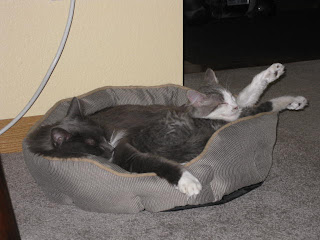Kirby had been seen for regular wellness visits like clockwork. The day I first met this handsome boy, he was 2 years of age. He had come in for a routine physical exam and basic blood work. The bad news came the next day when the heartworm test was POSITIVE. Another test confirmed the positive result. Kirby’s disease could have gone undetected had Jack not fallen in love with this dog when he did.
Many folks will hear that we don’t have heartworm disease in Colorado. This couldn’t be further from the truth. We don’t see as much as many other states, thankfully. But, we see it. In fact, Care Animal Hospital has seen 7 positive heartworm cases within the last 2 years!!!
Disaster situations such as Hurricane Katrina and the tornado in Joplin, Missouri result in the displacement of family and shelter pets. Shelters become overcrowded on a good day. Disasters make the shelters even more congested. Where do these dogs go? Colorado is known to have some of the best pet owners in the country. We are also known to have a high adoption rate of shelter animals. It stands to reason that many of these animals come in to our shelter system. They bring with them heartworm disease and other parasites in many cases.
Heartworm disease is the infection of the parasite, Dirofilaria immitis. When a mosquito bites an infected dog, it picks up the microfilarial (pre-larvae) stage of D.immitis from the dog’s bloodstream. These microfilariae transition through three larval stages while inside the mosquito. The third larval stage is the “infective” stage.
Now the infected mosquito bites another dog. The third-stage larvae are deposited next to the site where the mosquito’s mouth parts puncture the dog’s skin. Within 3-12 days, the larvae can be found within various tissues of the dog. In this time, they also molt from third-stage to fourth-stage larvae. They continue their travels in the dog’s tissues until days 50-70 when they take up residence in the vessels around the lungs. By now, they have molted to the final stage and are full-fledged worms. By day 70, these worms are nearly 1.5 inches long.
WHAT ARE THE SYMPTOMS OF HEARTWORM DISEASE?
The following summary is from the American Heartworm Society.
HOW IS HEARTWORM DISEASE TREATED?
Treatment is a sequence of events that is often spread out to deal with the organism’s ever-changing life stages occurring within the dog. Several weeks to months of medication to kill the third- and fourth-stage larvae are often implemented to prevent these juvenile organisms from maturing to adult worms. Chest radiographs are essential to try to classify the severity of disease (Class I, 2, 3, or 4) and to determine the extent of injury to the heart, lungs, and blood vessels.
The use of the antibiotic, Doxycycline, may be used to attempt to sterilize the female worms within the dog. While this will not kill the worms, it may reduce their likelihood of reproducing.
Immiticide is given with a long needle, deep in the muscles in the lower back. The injection can be quite painful. After the first injection and close observation for side effects, the dog will go home with strict instructions to be kept very quiet for another month. The dog is generally kept in a crate or closed off area the entire time. He does not receive any exercise. He is on a leash to urinate and defecate, and then returned to his crate. The dog often receives sedative to help quiet him down during this timeframe.
The goal is to not allow the dog to get excited which causes the heart rate to increase. As the heart rate increases, so do the odds for a severe reaction as dead worm carcasses are carried in the blood stream and can block a pertinent vessel or heart valve. This would result in an embolism which can immediately kill the dog. Second, as the worms are dying, chemicals are released from their decomposing bodies that may result in a severe reaction, including anaphylaxis. This, too, can be life-threatening.
After one month, the dog returns and receives 2 more injections given 24 hours apart. The dog will go through at least another month of sedation and no activity.
The dog does not have another heartworm test for 7-9 months after the final treatment. Some cases require a second treatment which is costly, dangerous, and hard for both the pet and owners.
Severe cases may require more aggressive means of removing the worms. Manual worm extractions can be done in specialty practices with a device that travels directly to the dogs heart and removes worms through the jugular vein and right heart.
HOW CAN I PREVENT HEARTWORM DISEASE?
You can reduce the likelihood of an infection by giving a recommended heartworm preventative on time each month for the life of the dog. We recommend Merial’s Heartgard Plus™ . This product is used in early diagnoses to kill off the young larvae before they can mature into worms. Heartgard Plus™ also contains an added ingredient to protect against a variety of intestinal worms too.
Test your dog yearly. The increasing number of positive cases we have seen warrants annual testing. The most diligent owner cannot always know if their dog receives his medication then goes outside and vomits. You would never know that this dose was missed. Testing yearly is worth every penny and gives us all peace of mind.
The American Heartworm Society’s website is a wealth of information!
The bottom line…
Heartworm disease is deadly.
Heartworm disease treatment is painful.
Heartworm disease is expensive.
Treatment can be life-threatening.
HEARTWORM DISEASE IS PREVENTABLE!
What happened to Kirby, the Great Pyrenees?



































